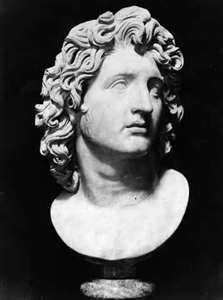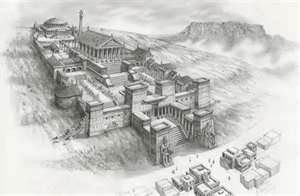Ancient Alexandria
Egypt's Alexandria was founded by one of the world's most famous figures and has endured as one of the world's most famous cities.
When Alexander departed for further battles against Persian King Darius III, a viceroy named Cleomenes directed the construction of the city. Alexander never returned, but his legacy lived on in the streets, studies, and reputation of the city that still bears his name. The city grew quickly, eclipsing Carthage and other former seats of power. In little more than 100 years, Alexandria was the largest city in the world. For centuries, it was second only to Rome in terms of both population and influence. As the crossroads between east and west, north and south, Alexandria served as home to many communities, including a very large Greek population and, at that time, the largest urban Jewish population in the world. A Greek translation of the Hebrew Bible known as the Septuagint was produced in Alexandria.
The city planners divided the city into five (despite the name) quarters, of which Rakhotis was one. The others were the Brucheum, or royal quarter; the gymnasium; the Soma; and the Museion. The Brucheum ended up being the largest of the quarters, housing a succession of royal palaces, along with temples, the theater, the royal cemetery, and the Great Library. The Brucheum also housed the mausoleum of Alexander (although his body and tomb have yet to be found). In addition to the Great Library, Alexandria's other great attraction was the Pharos Lighthouse, one of the Seven Ancient Wonders of the World. On an isthmus across the harbor from the city, the Pharos was built a couple of generations after the city's founding and survived for centuries before succumbing to a series of devastating earthquakes. Commissioning the construction of both of these was Ptolemy I, a trusted general and friend of Alexander who became the leader of Egypt and founded a dynasty that lasted three centuries.
The city passed to Persian rule in 619, was again in Western hands in 629, under the Byzantine Emperor Heraclius, but then fell under the Muslim hammer in 641 and stayed under that influence for many centuries. Ottoman Turks captured the city in 1517 and ruled it until 1798, when French troops under Napoleon occupied the city. Napoleon's hold on Alexandria was brief, as the British claimed possession of the city in 1801. Like much of the rest of Egypt, the city remained under British control or influence for another 150 or so years.
|
|
Social Studies for Kids
copyright 2002–2025
David White




 The city plan called for a Hippodomi, or quadrilateral grid, plan. This kind of plan, incorporating two main streets that cross at right angles, was common in Greek cities at the time. In addition, side streets ran parallel to the two main streets. From above, the city layout looked like a chessboard. The story goes that the grid was laid out using barley flour.
The city plan called for a Hippodomi, or quadrilateral grid, plan. This kind of plan, incorporating two main streets that cross at right angles, was common in Greek cities at the time. In addition, side streets ran parallel to the two main streets. From above, the city layout looked like a chessboard. The story goes that the grid was laid out using barley flour. Alexandria fell under Roman rule in 30 B.C. After a devastating series of wars in the 2nd Century A.D., the Roman Emperor
Alexandria fell under Roman rule in 30 B.C. After a devastating series of wars in the 2nd Century A.D., the Roman Emperor 
